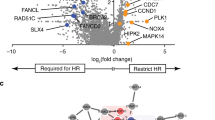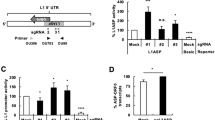Abstract
The cloning of a full-length cDNA for the gene (ATM) mutated in the human genetic disorder ataxia-telangiectasia (A-T) has been described recently. This cDNA, as well as a fragment representing a functional region from ATM, are capable of rescuing various aspects of the radiosensitive phenotype in A-T cells. We have subcloned full-length ATM cDNA in the opposite orientation in an EBV-based vector under the control of an inducible promoter to determine whether this anti-sense construct might sensitize control lymphoblastoid cells to ionizing radiation. The effectiveness of expression of this construct in control cells was monitored by loss of ATM protein which was evident over a period 6–12 h after induction. Under these conditions radiosensitivity was enhanced approximately threefold in control cells, approaching the degree of radiosensitivity observed in A-T cells. Expression of the anti-sense construct also increased the number of radiation-induced chromosomal breaks and led to the appearance of radioresistant DNA synthesis in these cells. Abrogation of the G1/S checkpoint was evident from the loss of the p53 response and that of its downstream effector, p21/WAF1, post-irradiation. The extent of accumulation of transfected cells in G2/M phase at 24 h post-irradiation was similar to that observed in A-T cells and the induction of stress-activated protein kinase by ionizing radiation was prevented by antisense ATM cDNA expression. These data demonstrate that full-length ATM anti-sense cDNA, by reducing the amount of ATM protein, is effective in imposing a series of known defects characteristic of the A-T phenotype. This inducible system provides an experimental model to further investigate mechanisms underlying radiosensitivity and cell cycle control.
This is a preview of subscription content, access via your institution
Access options
Subscribe to this journal
Receive 50 print issues and online access
$259.00 per year
only $5.18 per issue
Buy this article
- Purchase on Springer Link
- Instant access to full article PDF
Prices may be subject to local taxes which are calculated during checkout
Similar content being viewed by others
Author information
Authors and Affiliations
Rights and permissions
About this article
Cite this article
Zhang, N., Chen, P., Gatei, M. et al. An anti-sense construct of full-length ATM cDNA imposes a radiosensitive phenotype on normal cells. Oncogene 17, 811–818 (1998). https://doi.org/10.1038/sj.onc.1202007
Received:
Revised:
Accepted:
Published:
Issue Date:
DOI: https://doi.org/10.1038/sj.onc.1202007
Keywords
This article is cited by
-
HSV-1 amplicon vector-mediated expression of ATM cDNA and correction of the ataxia–telangiectasia cellular phenotype
Gene Therapy (2003)
-
Regulation and mechanisms of mammalian double-strand break repair
Oncogene (2003)
-
Transcriptional downregulation of ATM by EGF is defective in ataxia-telangiectasia cells expressing mutant protein
Oncogene (2001)
-
Downregulation of the type 1 insulin-like growth factor receptor in mouse melanoma cells is associated with enhanced radiosensitivity and impaired activation of Atm kinase
Oncogene (2001)
-
Caspases and mitochondria in c-Myc-induced apoptosis: identification of ATM as a new target of caspases
Oncogene (2000)



